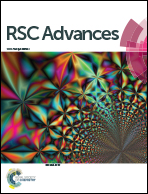New approach to improve the conductivity of apatite-type lanthanum germanate La9.33Ge6O26 as electrolyte for IT-SOFCs†
Abstract
Apatite-type La9.33Ge6O26 powders have been successfully synthesized by a facile molten-salt synthesis method, using NaCl as a eutectic salt. The morphology, structure and phase composition of the powders were examined. The results demonstrated that the apatite-type La9.33Ge6O26 powders are homogeneous, nano-size, non-agglomerated and well crystallized particles, which are favorable to obtain highly dense pellets. Compared with the conventional methods, dense pellets have been successfully sintered at a relatively low temperature of 1100 °C, which inhibits the vaporization of GeO2. The pellets exhibit a higher conductivity with a value of 2.4 × 10−2 S cm−1 at 850 °C, due to the high density and the avoidance of impurity La2GeO5. The main problems such as Ge volatility, agglomeration and crystallinity encountered in the conventional methods have been effectively solved via the molten-salt synthesis method. In addition, the related mechanism is also discussed in the present paper.


 Please wait while we load your content...
Please wait while we load your content...